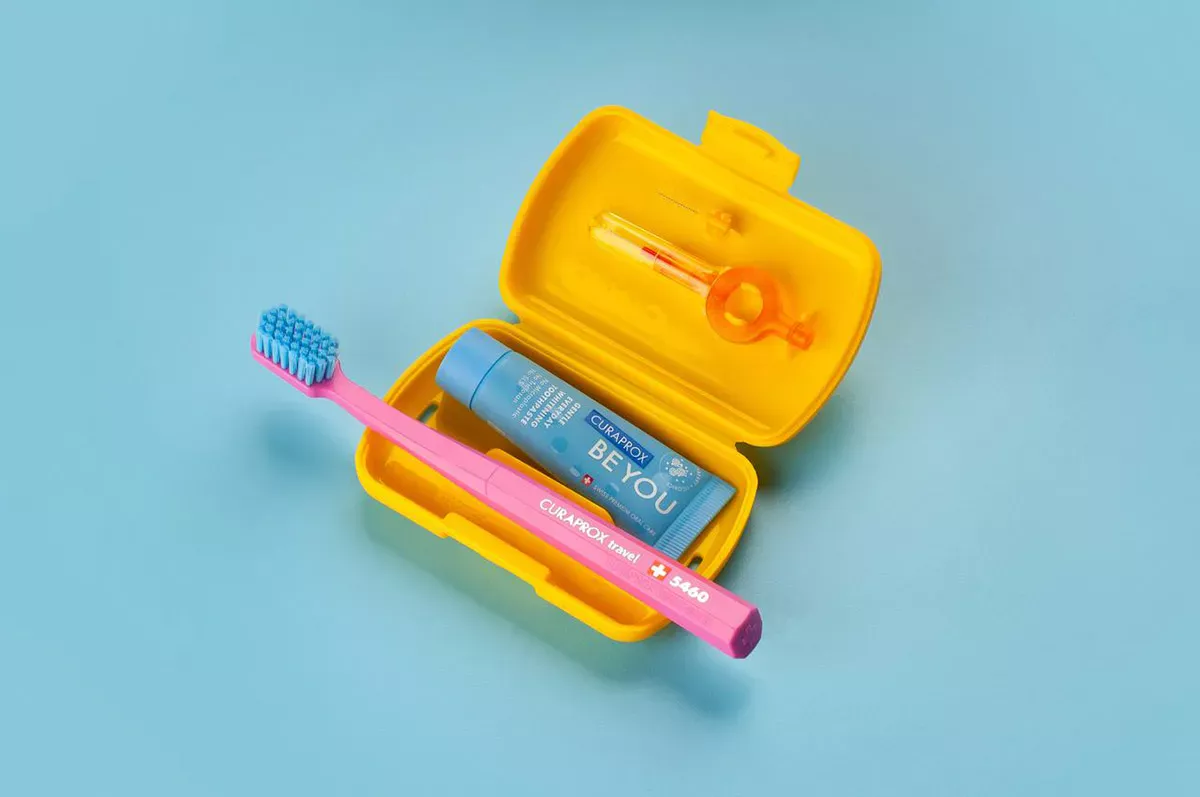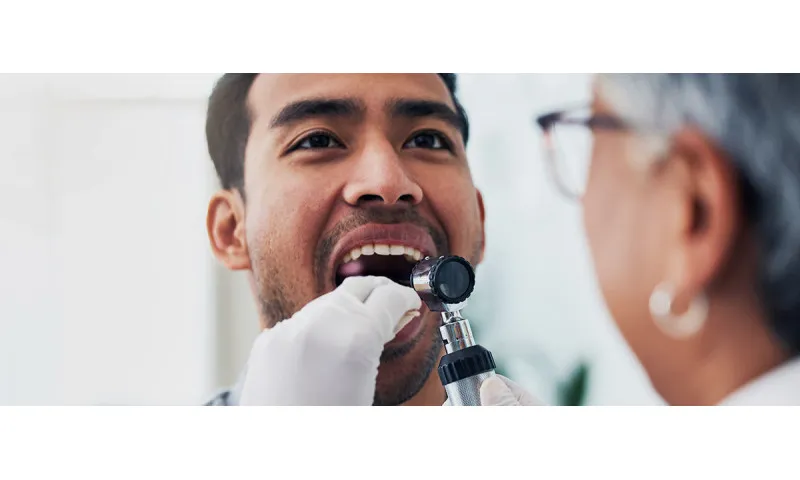Brushing teeth without toothpaste: Does it actually work?
From a historical perspective, toothpaste is a relatively new invention in the annals of civilization. Over 5,000 years ago, the ancient Egyptians practised oral hygiene using twigs from the toothbrush tree (Salvadora persica) – without toothpaste, of course. Germanic tribes did not have toothpaste either.
However, the Romans, who were progressive in many respects, already had an inclination for toothpaste, although it differed significantly from the one in our bathroom cabinets today. In ancient Rome, dental care enthusiasts used a blend of ground bones, salt, honey and oil to brush their teeth.
Thankfully, modern-day toothpaste has come a long way from its bone-like taste and is now available in various delightful flavours – for instance toothpaste with gin tonic flavour. But is that really necessary?
The fact is: When brushing your teeth, the mechanical cleaning technique with a toothbrush is more important than the individual components of your toothpaste. Although they help strengthen your teeth and keep them healthy for longer, they are not absolutely necessary. However, when brushing your teeth without toothpaste, particularly strict rules apply, especially if you intend to adopt this practice permanently.
Why do we use toothpaste?
In recent decades, the cases of dental caries have decreased significantly. The reason for this? Fluoride toothpaste. Fluoride strengthens the enamel of your teeth and protects them against dental decay. It helps restore vital minerals to your teeth after exposure to bacteria acid. The enamel is thus better protected against daily acid attacks from products like coffee, fruit and soft drinks. Sugar and other carbohydrates are also converted into acid in your mouth.
For many decades, the enamel-protecting effect of fluoride has been a well-known fact in the dental field. Despite its established benefits, unfounded rumours about fluoride's potential harm continue to circulate online. Fluoride is indeed toxic – but only to a minimal degree. To demonstrate its harmful effects, an adult would need to consume the contents of approximately 23 tubes of toothpaste. Fluoride is also safe for children, including babies, and is endorsed by both the European Academy of Paediatric Dentistry and the German National Association of Statutory Health Insurance Physicians (KZBV), starting from the eruption of the very first tooth.
Good to know:
In addition to fluoride, Curaprox toothpastes contain enamel-strengthening enzymes that are also found in saliva, offering a particularly natural and gentle approach. Further, no aggressive additives are used in these products. Our toothpastes steer clear of microplastics, foam cleansers harmful to mucous membranes and triclosan.
The "dry brushing" trend: Brushing teeth without toothpaste and water
Some individuals take it a step further by abstaining not only from harmful additives but also from toothpaste and water in general. This emerging trend is gaining popularity, particularly through social networks, and is referred to as "dry brushing".
The proponents of this "no chemicals" approach reject the use of any chemicals in their mouths and solely rely on manual brushing for oral care. The reason for this? Brushing your teeth without toothpaste is the oldest and most natural form of dental care, dating back to ancient times. Additionally, toothbrushing without the use of foaming toothpaste facilitates the detection of problem areas that require more thorough cleaning. Since: Your teeth only feel clean when they are truly clean.
Tooth by tooth: "Dry brushing" with the solo technique
At Curaprox, "dry brushing" is nothing new. Jiří Sedelmayer, dentist, prophylaxis pioneer and creator of our personalised training programme for dental professionals, devised the solo brushing technique and single brush years ago. This unique single-tuft brush features a small head, enabling precise cleaning along the gum line, following the contours of each tooth meticulously.
This ultra thorough toothbrushing method is called the "solo technique" and does not require toothpaste or water. Hence, you can truly relax and enjoy the toothbrushing experience. Watch TV or read a book while calmly brushing each tooth individually along the gum line. You can even take the small brush with you and clean your teeth on a train or plane – without the need for water or toothpaste.
However, this toothbrushing method with the single-tuft brush takes much longer than the recommended three minutes required for regular toothbrushing in the morning and evening. The outcome is, however, an extraordinary sense of cleanliness.
Discover a video tutorial on how to brush your teeth thoroughly without toothpaste here:
Good to know:
The Curaprox single-tuft brush boasts a head shape and filaments precisely designed to match the anatomy of the gum line. It is available both as a manual toothbrush and as an attachment for the electric toothbrush.
How can you brush your teeth when out and about without toothpaste?
Not everyone willingly abstains from toothpaste when brushing their teeth. Especially when travelling, it can come as quite a shock when, after rummaging through your toiletry bag, you realise that you left your toothpaste at home next to the empty toothbrush mug. But do not worry:
In an emergency, you can also brush your teeth with a normal toothbrush without toothpaste. Embrace the situation and give "dry brushing" a go. After all, you can also remove food debris and dental plaque without toothpaste, thereby depriving bacteria of their primary source of sustenance. According to the principle: Brushing your teeth without toothpaste is better than going to bed with completely unbrushed teeth. You can, of course, also rinse your mouth with water.
Are there any suitable home remedies for brushing teeth?
Brushing your teeth without toothpaste is a real trend. The Internet is full of tips on how to brush your teeth with simple home remedies or how to make your own toothpaste. Many home remedies are even said to have a whitening effect. But do they really work? And are they recommendable? In most cases, the answer here is quite clearly: No. Discover below why most home remedies do more harm than good:
Brushing teeth with baking powder or bicarbonate of soda
Bicarbonate of soda is a classic DIY product for body care and widely recommended in alternative beauty blogs as a natural toothpaste substitute for natural whitening. Homemade toothpastes using bicarbonate of soda, coconut oil and essential oils are popular choices. Do they work? Bicarbonate of soda actually whitens teeth by forming a chemical compound with water when brushing your teeth.
So, how often can you brush your teeth with baking powder or bicarbonate of soda? In our opinion, never. Since both baking powder and bicarbonate of soda attack the enamel of your teeth. The coarse-grained powder acts like an abrasive and rubs off the enamel. The combination of bicarbonate of soda or baking powder with citric acid is particularly damaging, as it further attacks the enamel.
The difference between baking powder and bicarbonate of soda lies in their composition. Bicarbonate of soda is pure sodium hydrogen carbonate, while baking powder includes an acid and a separating agent.
Brushing teeth with salt
Grains of salt are also too harsh for brushing and, like bicarbonate of soda and baking powder, have an abrasive impact on the enamel of your teeth. They are akin to a body scrub, but unfortunately the enamel does not regenerate. Hence, it is best to give salt a miss when brushing your teeth.
Brushing teeth with pure activated charcoal
Activated charcoal effectively binds toxins and colour particles, offering natural teeth whitening benefits. That is why some people choose to brush their teeth with pure activated charcoal. To do so, they simply dip the toothbrush in activated charcoal powder and start brushing. However, a measure of caution is called for here, too. Activated charcoal is an excellent natural bleaching agent, but in its pure form it can be too coarse and harm the enamel of your teeth.
If you want to use the whitening effect of activated charcoal without harming your teeth, simply opt for a whitening toothpaste with activated charcoal. Important: The RDA value, short for relative dentin abrasivity, indicates the extent to which a toothpaste can wear away your enamel. Gentle toothpastes have an RDA value below 70, while values above 100 can be hazardous for your teeth.
How often can you brush your teeth with activated charcoal toothpaste? Toothpastes with an RDA value below 100 are suitable for daily use. Pure activated charcoal powder, on the other hand, should not be used at all or should only be applied as a "mask" and rinsed off without using it to brush your teeth.
Good to know:
The 'Black is white' toothpaste from Curaprox relies on the natural whitening power of activated charcoal and boasts an RDA value of 90. This is actually quite a low value for a whitening toothpaste. Apart from activated charcoal, the toothpaste includes fluoride and an enzyme that is also found in saliva, ensuring gentle and natural cleaning of your teeth. In fact, our toothpaste does not contain any harmful ingredients or unnecessary chemicals.
Brushing teeth with turmeric
Turmeric, an intense yellow spice commonly used in curry dishes, boasts remarkable anti-inflammatory and antibacterial properties. Moreover, it has also gained recognition as a natural teeth whitener. Is turmeric thus suitable for brushing teeth, and if the answer is yes, how frequently should you use it?
Brushing your teeth with turmeric is both messy, due to its intense staining effect, and relatively ineffective. For most people, the promised brightening effect either fails to happen or occurs only minimally. There is also a risk that plastic implants or cracks in the enamel will turn yellow. So, if you want to brush your teeth with turmeric, you should have spotless teeth to start with. Our recommendation: Enjoy a delicious curry with turmeric instead and use a normal toothpaste for brushing your teeth.
Brushing teeth with wood ash
Forgotten to take toothpaste along on your camping trip? For safety and hygiene reasons, please avoid brushing your teeth with ashes from the campfire or using them to create a makeshift toothpaste! While it may seem adventurous and liberating, ash crystals and potassium can harm the enamel of your teeth. Besides, it is supposed to taste dreadful.
Recommended without hesitation: Brushing teeth with coconut oil
The antibacterial properties of coconut oil make it a great alternative for brushing your teeth, especially if you run out of toothpaste when you are all already in your pyjamas. Simply put some coconut oil on your toothbrush or directly on your teeth and brush as usual for three minutes. How often? Twice a day just like brushing your teeth with toothpaste – in the morning after breakfast and at night before going to bed. However, please keep in mind that coconut oil does not contain fluoride or any active ingredients that protect the enamel of your teeth. For long-term use, toothpaste is, therefore, the preferable option.
Forgotten your toothbrush? The following alternative options are available
You have just arrived at the hotel, unpack your toiletry bag and then realise: No toothbrush– what can you do? It is, of course, frustrating, but not the end of the world. Here are a few tips for brushing your teeth if you have forgotten your toothbrush:
1. Search the hotel bathroom and ask at the reception desk
A small toothbrush set with a mini tube of toothpaste can often be found in hotel bathrooms. If not, you can also ask at the reception desk. The hotel staff will gladly assist you and might even have a toothbrush for you or at least tell you where you can purchase one.
2. Drive to the nearest petrol station
Your hotel is not able to help you? Then you can either drive or take a taxi to the nearest petrol station if there is no small shop within walking distance. Petrol stations usually stock toothbrushes and also toothpaste.
3. Use your finger
You remembered to pack toothpaste but forgot your toothbrush, and there is no petrol station nearby? Or you are just too tired to leave your hotel room? In exceptional cases, you can use your finger as a toothbrush substitute. Just put some toothpaste on your finger and brush your teeth as thoroughly as possible. Make sure that you have washed your hands properly though before using your finger as a toothbrush.
Caution! This toothbrushing technique is ineffective and definitely not recommended for everyday use. In fact, using a toothbrush without toothpaste is more effective than the finger trick for cleaning your teeth. So, only use it in emergencies.
4. Chew gum
Chewing gum is a good emergency solution if you have forgotten both your toothpaste and toothbrush. As chewing gum at least cleans the chewing surfaces of your teeth. Chewing also stimulates saliva production, washing away bacteria and protecting the enamel of your teeth.
Good to know:
The 'Black is white' chewing gum from Curaprox not only protects your teeth against dental decay thanks to xylitol, but also provides a whitening effect due to the fine activated charcoal, delivering a fresh taste and a radiant white smile.
5. Use dental floss or interdental brushes
You have interdental brushes or dental floss but no toothbrush in your toiletry bag? In this case, at least brush your interdental spaces as usual. Did you know that interdental brushes are much better for this than dental floss?
6. Eat a carrot
If you happen to have raw food with you as a travel snack, you are in luck! Chewing on a carrot for an extended period of time stimulates the flow of saliva, naturally cleaning your teeth, much like chewing gum. The hard consistency of the carrot can also help to scrape plaque from your teeth. However, its efficiency is definitely not comparable to a toothbrush.
7. Drink tea with a disinfecting effect
Does your room have a kettle and tea making facilities? If so, you can disinfect your mouth with green tea. Sage tea also has an antibacterial effect and can be helpful when attempting to clean your teeth without a brush. Simply make the tea, let it cool down and use it as a mouthwash. And, of course, buy a toothbrush the next day.
8. Do not use your partner's toothbrush
Although this can seem like the most tempting thing to do if you have forgotten your own toothbrush: Never use another person's toothbrush, not even your partner's. Rinsing their toothbrush thoroughly with water after brushing will not eliminate all the bacteria on it. And this also applies to cavity-causing bacteria, which are easily transmitted from the toothbrush to your mouth. So, please never share your toothbrush. If you accidentally use your partner's toothbrush by mistake, it is advisable to buy a new one afterwards.
Summary: Does brushing your teeth without toothpaste make sense long-term, or is it just a stopgap solution?
Whether by necessity or consciously: Brushing your teeth without toothpaste works and can even be useful. But only if you invest time and diligently brush each tooth with the 'solo technique' method. With a little practice, you can easily clean your teeth without toothpaste while out and about. However, brushing your teeth without a toothbrush is never the best idea.
Home remedies as an alternative to toothpaste are also not recommendable. Except for coconut oil, all home remedies have a negative impact on the enamel of your teeth. While coconut oil does not harm your teeth, it fails to actively protect them against dental decay or to accelerate their remineralisation. If you want to enjoy healthy teeth for years to come without the fear of hidden chemicals, opt for a toothpaste that is free of harmful ingredients.
FAQs: Brushing teeth while out and about
Brushing your teeth is important – also when on holiday. To make sure you are well prepared, we have answered some of the most frequently asked questions below:
Can I pack toothpaste in my hand luggage?
You are allowed to take toothpaste onto a plane in your hand luggage. However, toothpaste is considered a liquid. Therefore, only toothpaste tubes with a maximum content of 100 millilitres are allowed. In total, you can carry one transparent bag with a capacity of one litre of liquids in your hand luggage. So, plan ample space for your toothpaste.
Toothpaste, however, does not have to go in your hand luggage. If you are not planning to brush your teeth during the flight and have a long journey ahead, you can stow a larger tube of toothpaste in your normal luggage.
Good to know:
Due to the limit on liquids, it is quite handy to have a small tube of toothpaste. Our 'Be you' toothpaste comes in a convenient travel size of 10 ml. If you are a frequent flyer, the taster pack with six different flavours is a great option, allowing you to experience the entire delicious 'Be you' range.
Can I pack an electric toothbrush in my hand luggage?
Yes, you can take an electric toothbrush in your hand luggage and brush your teeth as usual, even on long-haul flights. If you do not need it during your flight, you can also stow it in your suitcase, of course.
What is the best way to transport toothpaste and a toothbrush?
Packing your toothpaste and toothbrush loosely in your backpack or suitcase is probably not the best idea. Besides being impractical, it is also unhygienic. Always protect your toothbrush:
Toothbrush case, travel box, tin, sleeve or travel container – there are lots of ways to transport your toothbrush safely. The important thing here is: To clean the toothbrush case regularly. Since dirt and other impurities accumulate there pretty quickly. Ideally, you have dried your toothbrush properly before transporting it.
Even more practical than a bulky toothbrush case is a compact travel set containing a small tube of toothpaste and a travel toothbrush, which easily fits into a full suitcase, backpack or even a handbag. Curaprox offers stylish travel sets in a range of seven colours each with a different flavour of the 'Be you' toothpaste or the 'Black is white' whitening toothpaste.
Particularly practical: In addition to the toothbrush and toothpaste, the travel set comes with two interdental brushes – for effectively cleaning the gaps between your teeth.
Good to know:
All our toothbrushes come with a practical protective cap. Thanks to the protective cap, you can simply put them in your toiletry bag without having to worry about brushing your teeth with shower gel or powder in the evening.
Sources
Allianz: Weiße Zähne: Sind Hausmittel sinnvoll?.
Anwalt.de: Ab in den Urlaub: Was darf bei Flugreisen in den Koffer oder in das Handgepäck?.
Bergwelten: So machst du dir deine Outdoor-Zahnpasta.
Detmar, Nico: Elektrische Zahnbürste im Handgepäck: Das müssen Sie wissen, at: praxistipps.chip.de.
Evidero: Natürliche Mundpflege: Strahlend schön lachen – Gesunde Zähne mit Kokosöl und Co..
Fachpraxis am Frauenplatz: Bleaching mit Kurkuma – funktioniert das?.
Gemeinschaftspraxis Dr. Merk und Partner: Zahnbürste teilen?.
Kassenzahnärztliche Bundesvereinigung (KZBV): Fluoride für Kinder.
Kassenzahnärztliche Bundesvereinigung (KZBV): Zahnschutz durch Fluoride.
Medicus Dental: Können Hausmittel die Zähne aufhellen?.
NDR: Handgepäck im Flugzeug: Was darf rein, was nicht?
Robert Koch-Institut: Mundhygiene und Kariesprophylaxe.
Schulte-Lünzum, Hannah: Zähneputzen ohne Zahnbürste: Tipps zum Improvisieren, at: praxistipps.focus.de.
Stiftung Warentest: Das braucht es für gesunde Zähne.
Stylebook: Trend „Dry Brushing“ – was bringt es, die Zähne ohne Zahnpasta zu putzen?.
Sulik, Petra: Aktivkohle für hellere Zähne?, at: zahnarzt-schwanenstadt.at.
Toumba, K.J. et al.: Guidelines on the use of fuoride for caries prevention in children: an updated EAPD policy document, in: European Archives of Paediatric Dentistry. 2019.
Wueste, Marco: Kosmetikbeutel im Handgepäck: Das sind die Regeln, at: praxistipps.chip.de.
Zahnarztpraxis Dr. Herdach & Deutsch: Hausmittel zum Bleaching: sinnvoll oder gefährlich?.
Zahnarztpraxis Gräml: Hausmittelchen um die Zähne weisser zu machen? Kommt drauf an.
Zahnaufhellung Test.de: Zähne aufhellen mit Kurkuma: geht das? Mein Erfahrungsbericht.
Zahnklinik Dreiländereck: Ratgeber: Warum benutzt man eigentlich Zahnpasta?.
All websites last accessed on 27 April 2023.
 Swiss premium oral care
Swiss premium oral care







